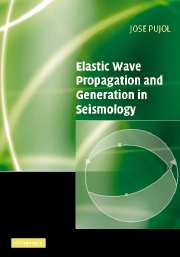Book contents
- Frontmatter
- Contents
- Preface
- Acknowledgements
- 1 Introduction to tensors and dyadics
- 2 Deformation. Strain and rotation tensors
- 3 The stress tensor
- 4 Linear elasticity – the elastic wave equation
- 5 Scalar and elastic waves in unbounded media
- 6 Plane waves in simple models with plane boundaries
- 7 Surface waves in simple models – dispersive waves
- 8 Ray theory
- 9 Seismic point sources in unbounded homogeneous media
- 10 The earthquake source in unbounded media
- 11 Anelastic attenuation
- Hints
- Appendices
- Bibliography
- Index
4 - Linear elasticity – the elastic wave equation
Published online by Cambridge University Press: 12 November 2009
- Frontmatter
- Contents
- Preface
- Acknowledgements
- 1 Introduction to tensors and dyadics
- 2 Deformation. Strain and rotation tensors
- 3 The stress tensor
- 4 Linear elasticity – the elastic wave equation
- 5 Scalar and elastic waves in unbounded media
- 6 Plane waves in simple models with plane boundaries
- 7 Surface waves in simple models – dispersive waves
- 8 Ray theory
- 9 Seismic point sources in unbounded homogeneous media
- 10 The earthquake source in unbounded media
- 11 Anelastic attenuation
- Hints
- Appendices
- Bibliography
- Index
Summary
Introduction
In the previous chapter we introduced the idea of small deformation, which allowed us to neglect the distinction between the Lagrangian and the Eulerian description. Now we will apply the small-deformation hypothesis to the equation of motion (3.5.3). The resulting equation will include spatial derivatives of the stress tensor, the acceleration of the displacement, and body forces. The displacement, in turn, is related to the strain tensor via (2.4.1). Therefore, we have two systems of equations, one for stress and displacement and one for strain and displacement. Within the approximations that have been introduced, these equations are valid for any continuous medium. To apply them to a specific type of medium (e.g., solid, viscous fluid) it is necessary to establish a general relation (known as a constitutive equation) between stress and strain.
In the case of solids, when a body is subjected to external forces it becomes deformed (strained), and internal stresses are generated within the body. The relation between stress and strain depends on the nature of the deformation and other external factors, such as the temperature. If the deformation is such that the deformed body returns to its original state after the force that caused the deformation is removed, then the deformation is said to be elastic. If this is not the case, i.e., if part of the deformation remains, the deformation is known as plastic.
- Type
- Chapter
- Information
- Elastic Wave Propagation and Generation in Seismology , pp. 84 - 99Publisher: Cambridge University PressPrint publication year: 2003
- 1
- Cited by



